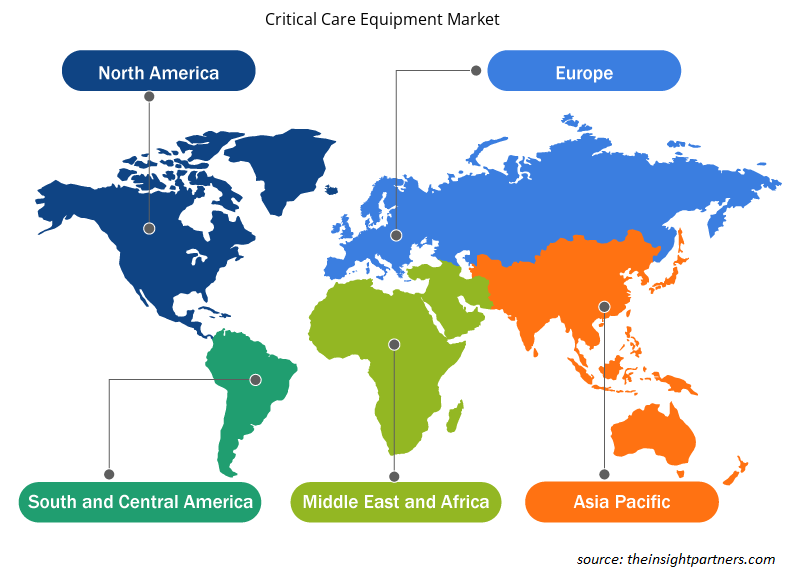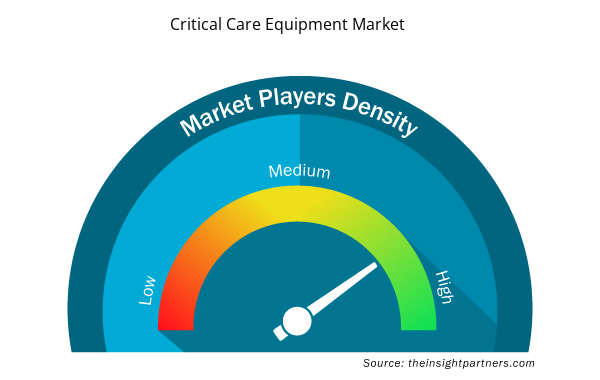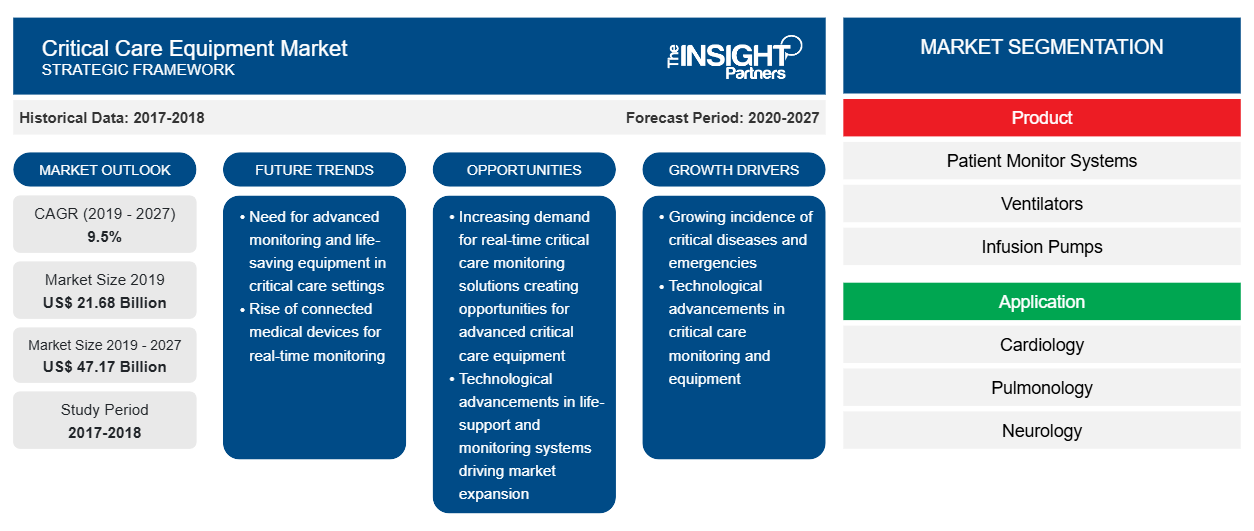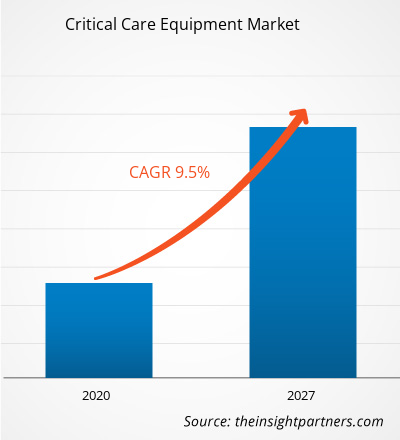بلغت قيمة سوق معدات الرعاية الحرجة 21,682.65 مليون دولار أمريكي في عام 2019 ومن المتوقع أن تصل إلى 47,171.42 مليون دولار أمريكي بحلول عام 2027؛ ومن المتوقع أن ينمو بمعدل نمو سنوي مركب قدره 9.5٪ خلال الفترة 2020-2027.
يقضي مرضى العدوى ما معدله 15 يومًا في العناية المركزة. ووفقًا للجمعية الأوروبية للتخدير، فإن عدد أسرة العناية المركزة في إيطاليا مستمر في النمو. في لومباردي، قبل انتشار فيروس كورونا، كان هناك 140 سريرًا للعناية المركزة الخاصة و500 سرير للعناية المركزة العامة، والتي زادت إلى أكثر من 900 بحلول نهاية مارس 2020.
قم بتخصيص هذا التقرير ليناسب متطلباتك
ستحصل على تخصيص لأي تقرير - مجانًا - بما في ذلك أجزاء من هذا التقرير، أو تحليل على مستوى الدولة، وحزمة بيانات Excel، بالإضافة إلى الاستفادة من العروض والخصومات الرائعة للشركات الناشئة والجامعات
- احصل على أهم اتجاهات السوق الرئيسية لهذا التقرير.ستتضمن هذه العينة المجانية تحليلاً للبيانات، بدءًا من اتجاهات السوق وحتى التقديرات والتوقعات.
رؤى السوق
زيادة عدد أسرة العناية المركزة في البلدان ذات معدل انتشار مرتفع لـ COVID-19 من شأنها أن تدفع نمو السوق
أعلنت منظمة الصحة العالمية أن مرض كوفيد-19 جائحة عالمية في الحادي عشر من مارس 2020. ويتميز هذا المرض الجديد بانخفاض عدد الحالات الأولية ثم انتشار العدوى في بلدان مختلفة. وعلى الرغم من تنفيذ عمليات الإغلاق للحد من انتشار مرض كوفيد-19، إلا أن أنظمة الرعاية الصحية في بلدان مختلفة أصبحت مثقلة بالطلب على المعدات، مثل أسرة العناية المركزة والمعدات الداعمة لعلاج حالات المرض الشديدة.
رؤى المنتجات
من حيث المنتج، استحوذ قطاع أنظمة مراقبة المرضى على أكبر حصة في السوق في عام 2019 ومن المتوقع أن يستمر في كونه المساهم الرائد خلال الفترة المتوقعة. ومع ذلك، من المتوقع أن يسجل قطاع أجهزة التنفس الصناعي معدل نمو سنوي مركب أعلى في السوق خلال الفترة المتوقعة.
رؤى التطبيق
بناءً على التطبيق، يتم تقسيم سوق معدات الرعاية الحرجة العالمية إلى أمراض القلب وأمراض الرئة وأمراض الأعصاب والعظام وغيرها. احتل قطاع أمراض القلب أكبر حصة من السوق في عام 2019، ومن المتوقع أن يسجل قطاع أمراض الرئة أعلى معدل نمو سنوي مركب خلال فترة التنبؤ. العناية المركزة القلبية الوعائية هي الإدارة النظامية للمرضى الذين يعانون من أمراض القلب والأوعية الدموية الشديدة (CVD)، بما في ذلك أمراض الأوعية الدموية وأمراض القلب. تعد أمراض القلب والأوعية الدموية من بين الأسباب الرئيسية للوفاة في جميع أنحاء العالم. على سبيل المثال، وفقًا لمنظمة الصحة العالمية، في عام 2016، توفي ما يقدر بنحو 17.9 مليون شخص بسبب أمراض القلب والأوعية الدموية، وهو ما يمثل 31٪ من الوفيات في جميع أنحاء العالم. وبالمثل، وفقًا لمراكز السيطرة على الأمراض والوقاية منها، يموت حوالي 655000 أمريكي من أمراض القلب كل عام. لمنع الوفاة بسبب أمراض القلب والأوعية الدموية، تتوفر وحدة عناية مركزة لمرضى أمراض القلب والأوعية الدموية الشديدة، وهي وحدة العناية المركزة لأمراض القلب والأوعية الدموية (CICU)، في المستشفيات العامة. إن التطورات التكنولوجية في طب القلب السريري، مثل الإجراءات والأجهزة التدخلية داخل الشرايين التاجية ومراقبة الدورة الدموية الغازية، هي التطورات الرئيسية في العناية المركزة لأمراض القلب والأوعية الدموية. وبالتالي، فإن عدد مرضى أمراض القلب والأوعية الدموية الشديدة الذين يتم إدخالهم إلى وحدة العناية المركزة لأمراض القلب والأوعية الدموية يتزايد كل عام. يعاني المرضى في وحدة العناية المركزة لأمراض القلب والأوعية الدموية من العديد من المضاعفات مثل الفشل التنفسي والفشل الكلوي. لذلك، هناك حاجة إلى طاقم طبي مدرب لممارسة العناية المركزة الشاملة.
ومن المتوقع أن تلعب التعاونات والشراكات التكنولوجية بين اللاعبين في سوق معدات الرعاية الحرجة لسد الفجوة بين العرض والطلب دورًا مهمًا في نمو السوق خلال الفترة المتوقعة.
رؤى إقليمية حول سوق معدات الرعاية الحرجة
لقد قام المحللون في Insight Partners بشرح الاتجاهات والعوامل الإقليمية المؤثرة على سوق معدات الرعاية الحرجة طوال فترة التوقعات بشكل شامل. يناقش هذا القسم أيضًا قطاعات سوق معدات الرعاية الحرجة والجغرافيا في جميع أنحاء أمريكا الشمالية وأوروبا ومنطقة آسيا والمحيط الهادئ والشرق الأوسط وأفريقيا وأمريكا الجنوبية والوسطى.

- احصل على البيانات الإقليمية المحددة لسوق معدات الرعاية الحرجة
نطاق تقرير سوق معدات الرعاية الحرجة
| سمة التقرير | تفاصيل |
|---|---|
| حجم السوق في عام 2019 | 21.68 مليار دولار أمريكي |
| حجم السوق بحلول عام 2027 | 47.17 مليار دولار أمريكي |
| معدل النمو السنوي المركب العالمي (2019 - 2027) | 9.5% |
| البيانات التاريخية | 2017-2018 |
| فترة التنبؤ | 2020-2027 |
| القطاعات المغطاة | حسب المنتج
|
| المناطق والدول المغطاة | أمريكا الشمالية
|
| قادة السوق وملفات تعريف الشركات الرئيسية |
|
كثافة اللاعبين في سوق معدات الرعاية الحرجة: فهم تأثيرها على ديناميكيات الأعمال
يشهد سوق معدات الرعاية الحرجة نموًا سريعًا، مدفوعًا بالطلب المتزايد من المستخدم النهائي بسبب عوامل مثل تفضيلات المستهلكين المتطورة والتقدم التكنولوجي والوعي المتزايد بفوائد المنتج. ومع ارتفاع الطلب، تعمل الشركات على توسيع عروضها والابتكار لتلبية احتياجات المستهلكين والاستفادة من الاتجاهات الناشئة، مما يؤدي إلى زيادة نمو السوق.
تشير كثافة اللاعبين في السوق إلى توزيع الشركات أو المؤسسات العاملة في سوق أو صناعة معينة. وهي تشير إلى عدد المنافسين (اللاعبين في السوق) الموجودين في مساحة سوق معينة نسبة إلى حجمها أو قيمتها السوقية الإجمالية.
الشركات الرئيسية العاملة في سوق معدات الرعاية الحرجة هي:
- شركة جنرال الكتريك
- ميدترونيك
- شركة ب. براون ميلسونجن ايه جي
- شركة باكستر الدولية
- شركة فيليبس الملكية
إخلاء المسؤولية : الشركات المذكورة أعلاه ليست مرتبة بأي ترتيب معين.

- احصل على نظرة عامة على أهم اللاعبين الرئيسيين في سوق معدات الرعاية الحرجة
حسب المنتج
- أنظمة مراقبة المريض
- أجهزة التنفس الصناعي
- أجهزة التنفس الصناعي
- أجهزة التنفس الصناعي غير الجراحية
- مضخات التسريب
- آحرون
حسب الطلب
- طب القلب
- طب الرئة
- طب الأعصاب
- طب العظام
- آحرون
حسب المستخدم النهائي
- المستشفيات
- مراكز الرعاية الطبية الخارجية
- الرعاية المنزلية
- آحرون
حسب الجغرافيا
- أمريكا الشمالية
- نحن
- كندا
- المكسيك
- أوروبا
- فرنسا
- ألمانيا
- إيطاليا
- المملكة المتحدة
- روسيا
- آسيا والمحيط الهادئ (APAC)
- الصين
- الهند
- كوريا الجنوبية
- اليابان
- أستراليا
- الشرق الأوسط وأفريقيا
- جنوب أفريقيا
- المملكة العربية السعودية
- الامارات العربية المتحدة
- أمريكا الجنوبية والوسطى (SCAM)
- البرازيل
- الأرجنتين
نبذة عن الشركة
- شركة جنرال الكتريك
- ميدترونيك
- شركة ب. براون ميلسونجن ايه جي
- شركة باكستر الدولية
- شركة فيليبس الملكية
- جيتنج ايه بي
- هاملتون الطبية
- شركة لوينشتاين الطبية المحدودة في المملكة المتحدة.
- شركة دراجرويرك ايه جي وشركاه
- شركة نيهون كوهدن
- شركة فيشر آند بايكل للرعاية الصحية المحدودة.
- شركة شنتشن ميندراي للإلكترونيات الطبية الحيوية المحدودة
- خط الأساس البي بي إل
- تريفيترون للرعاية الصحية
- شركة سكانراي للتكنولوجيا المحدودة
- شركة أساهي كاساي
- التحليل التاريخي (سنتان)، السنة الأساسية، التوقعات (7 سنوات) مع معدل النمو السنوي المركب
- تحليل PEST و SWOT
- حجم السوق والقيمة / الحجم - عالميًا وإقليميًا وقطريًا
- الصناعة والمنافسة
- مجموعة بيانات Excel



Report Coverage
Revenue forecast, Company Analysis, Industry landscape, Growth factors, and Trends

Segment Covered
This text is related
to segments covered.

Regional Scope
North America, Europe, Asia Pacific, Middle East & Africa, South & Central America

Country Scope
This text is related
to country scope.
الأسئلة الشائعة
The disruption of supply chain and logistics due to the rapid spread of COVID-19 is the significant factor that will hinder the critical care equipment market growth.
The global critical care equipment market is being driven by factors such growing number of ICU beds in countries with a high prevalence of COVID-19 and increasing demand for ventilators for the effective management of critical COVID-19 patients. Furthermore, technological innovations in critical care equipment is likely to offer significant opportunities for the growth of the global critical care equipment market.
Critical care equipment includes cardiac support, patient monitoring, respiratory support, emergency resuscitation devices, pain management, and other life support equipment designed to care for critically ill patients or have undergone a major surgical procedure, thereby requiring 24-hour care monitoring.
The List of Companies - Critical Care Equipment Market
- General Electric Company
- Medtronic
- B. Braun Melsungen AG
- Baxter International Inc.
- Koninklijke Philips N.V.
- Getinge AB
- Hamilton Medical
- Löwenstein Medical UK Ltd.
- Dragerwerk AG & Co. KGaA
- Nihon Kohden Corporation
- Fisher & Paykel Healthcare Limited.
- Shenzhen Mindray Biomedical Electronics Co., Ltd.
- BPL
- Trivitron Healthcare
- Skanray Technologies Pvt Ltd
- Asahi Kasei Corporation
The Insight Partners performs research in 4 major stages: Data Collection & Secondary Research, Primary Research, Data Analysis and Data Triangulation & Final Review.
- Data Collection and Secondary Research:
As a market research and consulting firm operating from a decade, we have published and advised several client across the globe. First step for any study will start with an assessment of currently available data and insights from existing reports. Further, historical and current market information is collected from Investor Presentations, Annual Reports, SEC Filings, etc., and other information related to company’s performance and market positioning are gathered from Paid Databases (Factiva, Hoovers, and Reuters) and various other publications available in public domain.
Several associations trade associates, technical forums, institutes, societies and organization are accessed to gain technical as well as market related insights through their publications such as research papers, blogs and press releases related to the studies are referred to get cues about the market. Further, white papers, journals, magazines, and other news articles published in last 3 years are scrutinized and analyzed to understand the current market trends.
- Primary Research:
The primarily interview analysis comprise of data obtained from industry participants interview and answers to survey questions gathered by in-house primary team.
For primary research, interviews are conducted with industry experts/CEOs/Marketing Managers/VPs/Subject Matter Experts from both demand and supply side to get a 360-degree view of the market. The primary team conducts several interviews based on the complexity of the markets to understand the various market trends and dynamics which makes research more credible and precise.
A typical research interview fulfils the following functions:
- Provides first-hand information on the market size, market trends, growth trends, competitive landscape, and outlook
- Validates and strengthens in-house secondary research findings
- Develops the analysis team’s expertise and market understanding
Primary research involves email interactions and telephone interviews for each market, category, segment, and sub-segment across geographies. The participants who typically take part in such a process include, but are not limited to:
- Industry participants: VPs, business development managers, market intelligence managers and national sales managers
- Outside experts: Valuation experts, research analysts and key opinion leaders specializing in the electronics and semiconductor industry.
Below is the breakup of our primary respondents by company, designation, and region:

Once we receive the confirmation from primary research sources or primary respondents, we finalize the base year market estimation and forecast the data as per the macroeconomic and microeconomic factors assessed during data collection.
- Data Analysis:
Once data is validated through both secondary as well as primary respondents, we finalize the market estimations by hypothesis formulation and factor analysis at regional and country level.
- Macro-Economic Factor Analysis:
We analyse macroeconomic indicators such the gross domestic product (GDP), increase in the demand for goods and services across industries, technological advancement, regional economic growth, governmental policies, the influence of COVID-19, PEST analysis, and other aspects. This analysis aids in setting benchmarks for various nations/regions and approximating market splits. Additionally, the general trend of the aforementioned components aid in determining the market's development possibilities.
- Country Level Data:
Various factors that are especially aligned to the country are taken into account to determine the market size for a certain area and country, including the presence of vendors, such as headquarters and offices, the country's GDP, demand patterns, and industry growth. To comprehend the market dynamics for the nation, a number of growth variables, inhibitors, application areas, and current market trends are researched. The aforementioned elements aid in determining the country's overall market's growth potential.
- Company Profile:
The “Table of Contents” is formulated by listing and analyzing more than 25 - 30 companies operating in the market ecosystem across geographies. However, we profile only 10 companies as a standard practice in our syndicate reports. These 10 companies comprise leading, emerging, and regional players. Nonetheless, our analysis is not restricted to the 10 listed companies, we also analyze other companies present in the market to develop a holistic view and understand the prevailing trends. The “Company Profiles” section in the report covers key facts, business description, products & services, financial information, SWOT analysis, and key developments. The financial information presented is extracted from the annual reports and official documents of the publicly listed companies. Upon collecting the information for the sections of respective companies, we verify them via various primary sources and then compile the data in respective company profiles. The company level information helps us in deriving the base number as well as in forecasting the market size.
- Developing Base Number:
Aggregation of sales statistics (2020-2022) and macro-economic factor, and other secondary and primary research insights are utilized to arrive at base number and related market shares for 2022. The data gaps are identified in this step and relevant market data is analyzed, collected from paid primary interviews or databases. On finalizing the base year market size, forecasts are developed on the basis of macro-economic, industry and market growth factors and company level analysis.
- Data Triangulation and Final Review:
The market findings and base year market size calculations are validated from supply as well as demand side. Demand side validations are based on macro-economic factor analysis and benchmarks for respective regions and countries. In case of supply side validations, revenues of major companies are estimated (in case not available) based on industry benchmark, approximate number of employees, product portfolio, and primary interviews revenues are gathered. Further revenue from target product/service segment is assessed to avoid overshooting of market statistics. In case of heavy deviations between supply and demand side values, all thes steps are repeated to achieve synchronization.
We follow an iterative model, wherein we share our research findings with Subject Matter Experts (SME’s) and Key Opinion Leaders (KOLs) until consensus view of the market is not formulated – this model negates any drastic deviation in the opinions of experts. Only validated and universally acceptable research findings are quoted in our reports.
We have important check points that we use to validate our research findings – which we call – data triangulation, where we validate the information, we generate from secondary sources with primary interviews and then we re-validate with our internal data bases and Subject matter experts. This comprehensive model enables us to deliver high quality, reliable data in shortest possible time.


 احصل على عينة مجانية لهذا التقرير
احصل على عينة مجانية لهذا التقرير